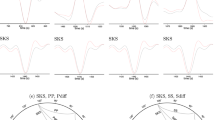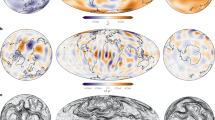Abstract
Fluid with a certain density and viscosity can rise by buoyant Poiseuille flow through a conduit1 within a second fluid of greater density and viscosity. Such conduits exhibit a rich behaviour characteristic of nonlinear systems, an aspect of which is the formation of solitary waves2,3. Here we present theoretical and experimental studies of these systems. Both approaches reveal that solitary waves trap material in a cell with closed streamlines and that the central streamline velocity is faster than the wave speed. Hence, parcels of deep material are transported directly upward over large distances. This is in contrast to the usual situation in which wave propagation through a medium causes only small displacement of fluid particles. Material in these parcels will be far less contaminated by diffusion from the surroundings than would be material in ordinary pipe flow. In addition, solitary waves are more efficient than buoyant spheres at conveying material upward. We suggest that such waves might exist in the Earth's mantle, conveying uncontaminated deep mantle material to the surface of the Earth.
This is a preview of subscription content, access via your institution
Access options
Subscribe to this journal
Receive 51 print issues and online access
$199.00 per year
only $3.90 per issue
Buy this article
- Purchase on Springer Link
- Instant access to full article PDF
Prices may be subject to local taxes which are calculated during checkout
Similar content being viewed by others
References
Whitehead, J. A. & Luther, D. S. J. geophys. Res. 80, 705–717 (1975).
Scott, D. S., Stevenson, D. L. & Whitehead, J. A. Nature 319, 759–761 (1986).
Olson, P. & Christensen, U. J. geophys. Res. 91, 6367–6374 (1986).
Huppert, H. E., Sparks, R. S. J., Whitehead, J. A. & Hallworth, M. A. J. geophys. Res. 91, 6113–6122 (1986).
Stacey, F. D. & Loper, D. E. Phys. Earth planet. Inter. 33, 45–55 (1983).
Olson, P., Schubert, G. & Anderson, C. Nature 327, 409–412 (1987).
Skilbeck, J. N. & Whitehead, J. A. Nature 272, 499–501 (1978).
Whitehead, J. A. Geophys. J. R. astr. Soc. 70, 415–433 (1982).
Whitehead, J. A. Am. J. Phys. 55, 998–1003 (1987).
Scott, D. S. thesis, California Institute of Technology, California (1987).
Taylor, G. I. Proc. R. Soc. A219, 186–203 (1953).
Taylor, G. I. Proc. R. Soc. A225, 473–477 (1954).
Turcotte, D. L. & Schubert, G. Geodynamics (Wiley, New York, 1982).
Hofmann, A. W. Terra Cognita 4, 157–165 (1984).
Griffiths, R. W. Earth planet. Sci. Lett. 78, 435–446 (1986).
Author information
Authors and Affiliations
Rights and permissions
About this article
Cite this article
Whitehead, J., Helfrich, K. Wave transport of deep mantle material. Nature 336, 59–61 (1988). https://doi.org/10.1038/336059a0
Received:
Accepted:
Issue Date:
DOI: https://doi.org/10.1038/336059a0
This article is cited by
-
Meandering instability of air flow in a granular bed: self-similarity and fluid-solid duality
Scientific Reports (2016)
-
Applications of KdV
Acta Applicandae Mathematicae (1995)
-
Thermal entrainment by deflected mantle plumes
Nature (1989)
Comments
By submitting a comment you agree to abide by our Terms and Community Guidelines. If you find something abusive or that does not comply with our terms or guidelines please flag it as inappropriate.



